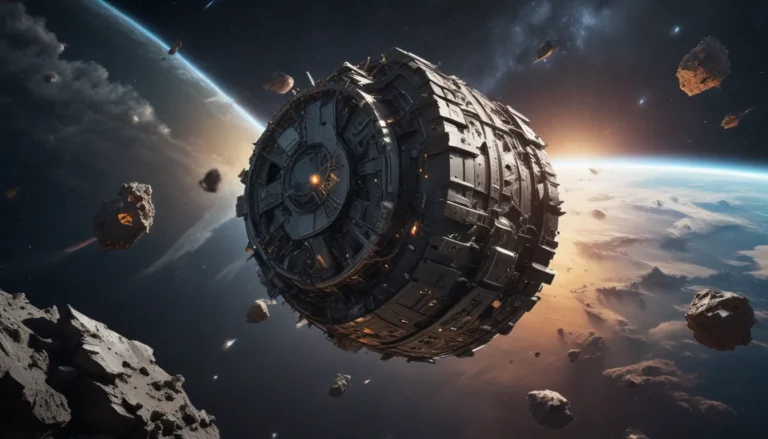The pictures we use in our articles might not show exactly what the words say. We choose these pictures to make you interested in reading more. The pictures work together with the words but don’t take their place. The words still tell you the important facts.
Embark on a remarkable journey through the cosmos as we delve into the realm of interstellar exploration. Join us as we unravel 11 captivating facts about the interstellar realm, shedding light on the mysteries that have intrigued scientists and stargazers for generations. Discover the vastness of space, the abundance of exoplanets, the enigmatic nature of black holes, and the thrilling quest for extraterrestrial life. Let's dive into the cosmic landscape and expand our knowledge of the universe's infinite possibilities.
The Marvels of the Vast Universe
Space, often referred to as the final frontier, is a boundless expanse filled with dazzling celestial objects. The observable universe stretches a staggering 93 billion light-years in diameter, hosting approximately 100 billion galaxies, each adorned with billions of stars.
Exoplanets: Worlds Beyond Our Reach
Among the cosmic wonders lie countless exoplanets, planets that exist outside our solar system. Astronomers have identified over 4,500 confirmed exoplanets to date, some of which reside within the habitable zones of their stars, offering a promising glimpse into the possibility of extraterrestrial life.
Unveiling Supermassive Black Holes
Black holes, enigmatic cosmic beings with gravitational pull so intense that not even light can escape, reside at the heart of most galaxies. Some black holes, known as supermassive black holes, weigh millions or even billions of times more than our sun, influencing the structure and development of their host galaxies.
The Speed of Light: A Cosmic Constant
In the realm of interstellar travel, the speed of light serves as a fundamental measure. Light speed races at an astonishing pace of approximately 299,792 kilometers per second (186,282 miles per second), allowing us to glimpse into the past as we observe distant stars and galaxies.
The Goldilocks Zone: Nature’s Sweet Spot
The Goldilocks Zone, also recognized as the habitable zone, represents the region around a star where conditions are just right for liquid water to exist on a planet's surface. This zone is pivotal in the pursuit of habitable exoplanets and potential life forms beyond our familiar Earth.
Pulsars: Beacons in the Cosmic Void
Pulsars, magnetic neutron stars in rapid rotation, emit beams of electromagnetic radiation akin to cosmic lighthouses. These sweeping beams offer astronomers invaluable insights into stellar evolution, gravity, and the behavior of matter in extreme conditions.
Nebulas: Cosmic Cradles of Creation
Nebulas, expansive clouds of gas and dust scattered across space, serve as stellar nurseries, birthing new stars as gravity compels gas and dust to condense and trigger nuclear fusion. The breathtaking displays exhibited by nebulae have captivated both astronomers and enthusiasts alike.
The Interstellar Medium: A Cosmic Tapestry
The interstellar medium denotes the vast expanses of space between stars, comprising gas, dust, and cosmic rays. Despite appearing empty, the interstellar medium plays a crucial role in the genesis and evolution of galaxies, serving as the foundational material for forthcoming stars and planetary systems.
Space Probes and Cosmic Missions
Humanity's thirst for exploration has prompted numerous space probes and missions that have ventured far beyond our planet. From the boundary-breaking Voyager probes voyaging towards the outskirts of our solar system to Mars rovers exploring the red planet's terrain, these missions have deepened our understanding of the universe.
Deciphering the Cosmic Microwave Background Radiation
The cosmic microwave background radiation (CMB) illuminates the faint glow of radiation lingering from the Big Bang. By studying this residual radiation, scientists gain insights into the early universe's formative stages, further enriching our comprehension of cosmic origins.
Pursuing Extraterrestrial Intelligence
Throughout history, humankind has pondered the existence of intelligent life beyond Earth. Initiatives like the Search for Extraterrestrial Intelligence (SETI) aspire to detect signals from extraterrestrial civilizations. Although contact remains elusive, the quest persists, fueled by our fascination with the prospect of cosmic companions.
In Conclusion: A Universe of Wonders Awaits
Interstellar exploration kindles our curiosity about the cosmos, unveiling a spectacle of wonders that transcend human understanding. From the expansive abyss of space to the quest for extraterrestrial life, the pursuit of comprehending our cosmic place persists as an ongoing endeavor.
Frequently Asked Questions
How far can interstellar travel take us?
Interstellar travel has the potential to carry us to neighboring star systems within our Milky Way galaxy and potentially beyond. However, the vast distances involved pose significant technical challenges beyond our current capabilities.
Are there habitable planets like Earth?
Astronomers have identified numerous exoplanets residing within habitable zones conducive to life. While some exhibit conditions favorable for life, further research is essential to conclusively determine their habitability.
Can anything escape a black hole’s grasp?
Nothing, not even light itself, can elude a black hole's gravitational pull. The boundary marking this point of no return is known as the event horizon.
How do space probes endure the harsh conditions of space?
Space probes are meticulously engineered to withstand the extreme conditions of space. They incorporate shielding against radiation, temperature regulation systems, and robust construction to endure the vacuum and microgravity of space.
Why is the cosmic microwave background radiation significant?
The cosmic microwave background radiation is vital as it serves as evidence for the Big Bang theory, offering insights into the universe's early stages. Through its analysis, scientists gain valuable knowledge about the cosmos' composition, age, and expansion.
Embark on this cosmic voyage with us as we unravel the mysteries of interstellar space and delve into the infinite wonders of the universe!






